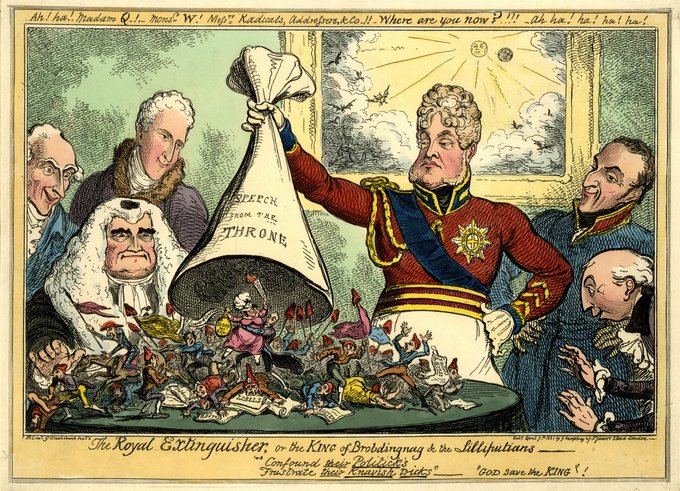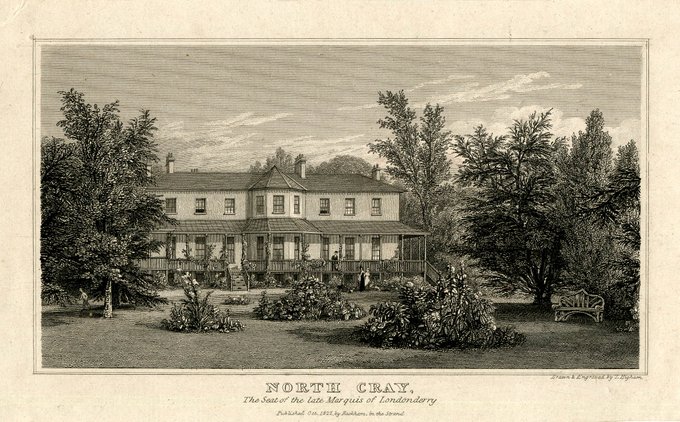castlereaghのTwitterイラスト検索結果。 16 件
These two well-known images by George Cruikshank are an excellent example of how visual satires could contribute to politicized public identities for individual politicians.
A 🧵
#twitterstorians #Castlereagh
(Images: British Museum collection)
Who was the Greatest Statesman of the Napoleonic era?
In a bar brawl of a first of two episodes debating contenders for this title, @AMikaberidze @latelordchatham @lureynol & @LandOfHistory discuss Metternich, Younger Pitt, Castlereagh & Nana Fadnavis
🎧 https://t.co/E9p8m6m2cz
Lord Castlereagh (1769-1822)
Robert Stewart, was an Anglo-Irish statesman. Serving as secretary to the Viceroy of Ireland, he suppressed the Rebellion of 1798 and secured the Irish act of union with Great Britain in 1800. He represented Britain at the Congress of Vienna
Up for auction at Sotheby's: Daniel Gardner's intriguing watercolour portrait of a young #ViscountCastlereagh, dated to the 1780s.
Here's hoping that it lands somewhere where it will be available for research🤞
#twitterstorians
https://t.co/lZ99vtIKbg
As we turn the corner into the week of August 12, I want to focus this #Castlereagh200 🧵 on a final area of #MentalHealth risk connected to the workplace: job insecurity.
Bear with me though--I turn this one on its head.
#ViscountCastlereagh #twitterstorians
1/14
Playing out at the same time, the trial of Queen Caroline represented a value conflict similar to those Castlereagh had experienced following the Irish Union: royal interests clashing with ministerial judgement.
11/
Moving later in Castlereagh's career, and into diplomacy, Castlereagh was personally accountable for trying to balance the conflicting values of Britain's constitutional system and the authoritarian monarchies of the Holy Alliance.
8/
For instance, in 1820 when Castlereagh was trying to manage increasingly fractious Continental allies, the King's insistence on pursuing a divorce from Queen Caroline ate up most of the Government's policy agenda (and Castlereagh's time) for an entire parliamentary session.
9/
Related to emotional discordance, it's also interesting to note that Castlereagh was, by most accounts, quite reserved by nature; one biographer termed him “a complete introvert,” and Princess Lieven found it “strange how timid he is,” and somewhat awkward in social settings.
11/
When at home, Castlereagh usually used his weekends for diplomacy, often reserving Sundays for in-person discussions with ambassadors etc either at his townhouse in St James Square or at the country home at North Cray. (Img: Higham, 1822, BM Collection) 11/
#OTD in 1809, the Foreign Secretary George Canning met the Secretary of State for War for a duel on Putney Heath. Castlereagh had discovered that Canning had been plotting behind his back to get him removed from the government. (1/5)
#OTD (June 18th) 1769, Robert Stewart, #ViscountCastlereagh is born.
I thought I'd take the opportunity to do a rough chronology of Castlereagh's life in official and unofficial portraiture, starting with a brilliant swagger portrait by Daniel Gardner, done c.1788. (Thread 1/ )
Viscount Castlereagh, Robert Stewart, 2nd Marquess of Londonderry.
Daniel Gardner による水彩+パステル画
年齢不明。恐らく20代前半。
In Stephanoff's larger painting, Castlereagh's unique robes make him easily recognisable in the crowd around the King. (Images: British Museum). Mrs. Arbuthnot wrote in her diary that "It was unanimously voted that he was the handsomest man in the procession."
5/5
#OTD in 1820 Lord Castlereagh presented to the Commons communications between the Queen and the PM, seeking to reach an amiable separation agreement. Learn more about the Queen Caroline Affair here, https://t.co/af2OZPbfNM #QueenCaroline200





























